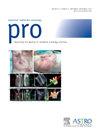Real-World Experience Using Proton Versus Photon Craniospinal Irradiation for Leptomeningeal Disease
IF 3.5
3区 医学
Q2 ONCOLOGY
引用次数: 0
Abstract
Purpose
Data demonstrate improved survival with proton craniospinal irradiation (CSI) over involved field radiation therapy for leptomeningeal disease (LMD). It is unknown how photon CSI compares in the treatment of LMD. We report our institution’s real-world experience using proton versus photon CSI for LMD.
Methods and Materials
We performed a retrospective review of LMD patients treated with photon or proton CSI from January 2021 to February 2024. All histologies were included. Patient characteristics and complete blood counts were collected before and after CSI. The primary endpoint was serious cytopenia likely caused by CSI. The median overall survival was estimated using the Kaplan-Meier method.
Results
Thirty-six patients with LMD treated with CSI (27 proton and 9 photon) were included. Across all major cell lines (hemoglobin, platelets, leukocytes, neutrophils, and lymphocytes), the rate of serious (grade 3 or higher) cytopenia likely caused by CSI was not different between the proton and photon groups (p > .21). The median overall survival in the proton and photon groups was 3.0 months and 1.7 months, respectively (hazard ratio, 1.49; p = .47).
Conclusions
In a single-institutional experience treating LMD, acute cytopenias likely caused by CSI were not different between proton and photon CSI across all major cell lines. Survival was also similar between modalities; therefore, photon CSI may be a safe, efficacious option for LMD.
使用质子与光子颅脊髓照射(CSI)治疗轻脑膜疾病的实际经验。
背景/目的:数据显示质子颅脊髓照射(CSI)优于受病灶放射治疗(IFRT)治疗轻脑膜病(LMD)可提高生存率。目前尚不清楚光子CSI在LMD治疗中的效果如何。我们报告了我们机构使用质子与光子CSI进行LMD的实际经验。方法:我们对2021年1月至2024年2月期间接受光子或质子CSI治疗的LMD患者进行回顾性分析。包括所有组织学。收集CSI前后患者特征及全血细胞计数。主要终点是可能由CSI引起的严重细胞减少。使用Kaplan-Meier法估计中位总生存期(OS)。结果:36例LMD患者接受了CSI治疗(27个质子,9个光子)。在所有主要细胞系(血红蛋白、血小板、白细胞、中性粒细胞、淋巴细胞)中,质子组和光子组之间可能由CSI引起的严重(3级或更高)细胞减少率没有差异(p > 0.21)。质子组和光子组的中位生存期分别为3.0个月和1.7个月(HR: 1.49; = 0.47页)。结论:在治疗LMD的单一机构经验中,在所有主要细胞系中,可能由CSI引起的急性细胞减少与质子CSI和光子CSI没有区别。两种治疗方式的生存率也相似,因此光子CSI可能是治疗LMD的一种安全、有效的选择。
本文章由计算机程序翻译,如有差异,请以英文原文为准。
求助全文
约1分钟内获得全文
求助全文
来源期刊

Practical Radiation Oncology
Medicine-Radiology, Nuclear Medicine and Imaging
CiteScore
5.20
自引率
6.10%
发文量
177
审稿时长
34 days
期刊介绍:
The overarching mission of Practical Radiation Oncology is to improve the quality of radiation oncology practice. PRO''s purpose is to document the state of current practice, providing background for those in training and continuing education for practitioners, through discussion and illustration of new techniques, evaluation of current practices, and publication of case reports. PRO strives to provide its readers content that emphasizes knowledge "with a purpose." The content of PRO includes:
Original articles focusing on patient safety, quality measurement, or quality improvement initiatives
Original articles focusing on imaging, contouring, target delineation, simulation, treatment planning, immobilization, organ motion, and other practical issues
ASTRO guidelines, position papers, and consensus statements
Essays that highlight enriching personal experiences in caring for cancer patients and their families.
 求助内容:
求助内容: 应助结果提醒方式:
应助结果提醒方式:


